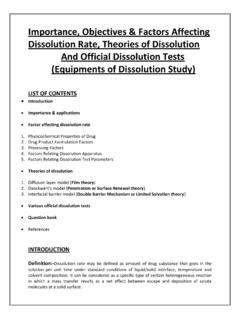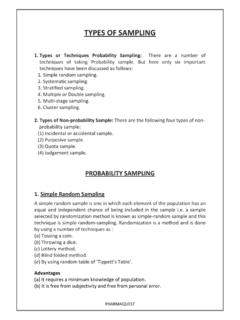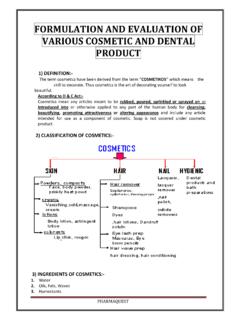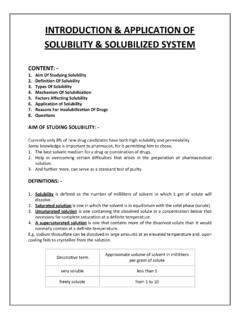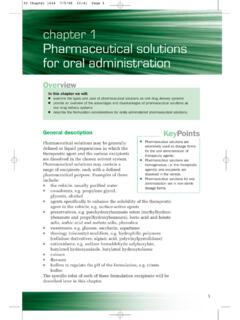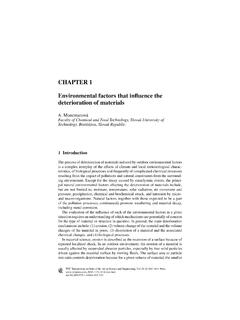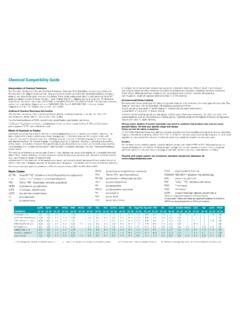Transcription of FACTORS AFFECTING DRUG ABSORPTION - PharmaQuesT
1 1 FACTORS AFFECTING DRUG ABSORPTION List of content :-- FACTORS A] Chemical FACTORS B] Physicochemical properties of drug substances solubility & dissolution rate 2. Particles size & effective surface area 3. Polymorphism & amorphism 4. Solvates & hydrates form of drug 6. Ionization state pKa & lipophilicity & GI pH ---pH partition hypothesis. C] Formulation FACTORS 1. Disintegration time 2. Manufacturing variables a. Method of granulation b. Compression force 3. Nature & type of dosage form 4. Pharmaceutical ingredients 5. Product age & storage conditions II PATIENT RELATED FACTORS [A] PHYSIOLOGICAL FACTORS (1) Membrane physiology A. Nature of cell membrane B. Transport processes (2) Gastero-Intestinal motility A.
2 Gastric emptying rate B. Intestinal motility C. Drug stability in GIT D. pH of GIT E. Surface area of GIT F. Intestinal transit G. Blood flow to GIT. H. Effect of food 2 (3) Age [B] CLINICAL FACTORS STUDY QUESTIONS REFRENCES Introduction Definitions Pharmacokinetics Evaluate the way in which a drug interacts with various barriers within a biological system Pharmacodynamics Study of the relationship between systemic exposure of a drug and it s biological effects on tissue ABSORPTION can be defined as the movement of active drug (or prodrug) from the site of administration across biologic barriers into a site where it is measured in the blood. This site of measurement is not specified.
3 Bioavailability can be defined as the fraction of administered drug that reaches the systemic circulation Note the difference in endpoint measurement sites FACTORS INFLUENCING GI ABSORPTION OF A DRUG FROM IT S DOSAGE FORM I PHARMACEUTICAL FACTORS : It include FACTORS relating to the- 3 [A] Chemical FACTORS A variety of chemical options can be used to improve the stability and systemic availability of drugs. For example, esters can be prepared of both acids and bases to produce more stable derivatives, which hydrolyse to the active parent once absorbed. The stability and solubility of both acids and bases tend to increase when they are in the form of salts. Typically, administration of soluble salts of penicillin give rise to higher circulating antibiotic levels than the free acid.
4 When the salt of a weak acid dissolves in the stomach, it generates a diffusion layer of relatively high pH which,in turn, promotes further dissolution . The same argument could theoretically be used for basic drugs. However, the pH effect in this case is swamped by the very low pH present in stomach fluids. Thus, salts of basic drugs are used primarily for handling and solubility rather than for improved dissolution . B] Physicochemical properties of drug substances solubility and dissolution rate The rate determining steps in ABSORPTION of orally administered drugs are: of dissolution III. Rate of drug permeation through the biomembrane. dissolution is rate limiting Permeation is rate limiting step for lipophillic drugs.
5 Step for hydrophilic drugs. Griseofulvin , Neomycin Imp prerequisite for the ABSORPTION of a drug is that it must be present in aq solution & this is depends on drug s aq solubility &its dissolution rate. 2. Particle size and effective surface area Smaller the particle size (by micronization) greater is the effective surface area more intimate contact b/w solid surface and aq solvent higher is the dissolution rate increase in ABSORPTION efficiency poorly aq soluble nonhydrophobic drugs like Griseofulvin, chloramphenicol whose dissolution is rate limited. Particle size reduction has been used to increase the ABSORPTION of a large number of poorly soluble drugs, such as bishydroxycoumarin, digoxin, griseofulvin, nitrofurantoin,and tolbutamide.
6 Drug in particle form Drug in solution form Drug in blood stream 4 Griseofulvin has extremely low aqueous solubility, and material of normal particle size gave rise to poor and erratic ABSORPTION . Microsize particles improve ABSORPTION , but it is improved even more when it is formulated in ultramicrosize particles as a monomolecular dispersion in polyethylene glycol. 3. Polymorphism and amorphism When sub exist in different crystalline form in polymorphic form then diff forms are Many compounds form crystals with different molecular arrangements, or polymorphs. These polymorphs may have different physical properties, such as dissolution rate and solubility. The vitamin riboflavin exists in several polymorphic forms, and these have a 20-fold range in aqueous solubility.
7 Polymorphs that have no crystal structure, or amorphic forms, have different physical properties from the crystalline forms. ABSORPTION of many orally administered drugs is controlled by dissolution rate. Amorphous forms generally dissolve faster than crystalline forms because no energy is needed to break up the crystal lattice. For this reason, the amorphous form is often preferred over the crystalline form and several drugs, including hydrocortisone and prednisolone, are marketed in the amorphic form. novobiocin 4. Solvates/hydrates During their preparation, drug crystals may incorporate one or more solvent molecules to form solvates. The most common solvate is water. If water molecules are already present in a crystal structure, the tendency of the crystal to attract additional water to initiate the dissolution process is reduced, and solvated (hydrated) crystals tend to dissolve more slowly than anhydrous forms.
8 Significant differences have been reported in the dissolution rate of hydrated and anhydrous forms of ampicillin, caffeine, theophylline, glutethimide, and mercaptopurine The clinical significance of these differences has not been examined but is likely to be slight. Solvates have greater solubility than their chloroform solvates of Griseofulvin, n-pentanol solvate of fludrocortisone. Stable form - Lowest energy state - Highest - Least aq solubility - dissolution rate limited Metastable form - Less stable form - Highest energy state - Lowest - Higher aq solubility - Better ABSORPTION and Bioavailability Amorphous form More soluble Rapidly dissolving Readily absorbed Crystalline form Less soluble Slower dissolving Not absorbed to significant extent 5 5.
9 Salt form of drug: -- At given pH, the solubility of drug, whether acidic/basic or its salt, is a constant. While considering the salt form of drug, pH of the diffusion layer is imp not the pH of the bulk of the solution. of salt of weak acid. ---Which increases the pH of the diffusion layer, which promotes the solubility and dissolution of a weak acid and ABSORPTION is bound to be rapid. Reverse in the case of salts of weak bases, it lowers the pH of diffusion layer and the promoted the ABSORPTION of basic drugs. Other approach to enhance the dissolution and ABSORPTION rate of certain drugs is by formation of in situ salt formation increasing in pH of microenvironment of drug by incorporating buffer aspirin, penicillin But sometimes more soluble salt form of drug may result in poor sodium salt of phenobarbitone and phenobarbitone, tablet of salt of phenobarbitone swelled, it did not get disintegrate thus dissolved slowly and results in poor ABSORPTION .
10 6 dissolution profile of various salts, where A) shows that potassium salt has the highest solubility B) shows the dissolution profile of various penicillin salts. 6. Ionization state :- Unionized state is imp for passive diffusion through membrane so imp for ABSORPTION . Ionized state is imp for solubility. 7. Drug pKa & lipophilicity & GI pH --- pH partition hypothesis: -- pH partition theory states that for drug compounds of molecular weight more than 100, which are primarily transported across the biomembrane by passive diffusion, the process of ABSORPTION is governed by pKa of drug The lipid solubility of the unionized drug pH at the ABSORPTION site.
